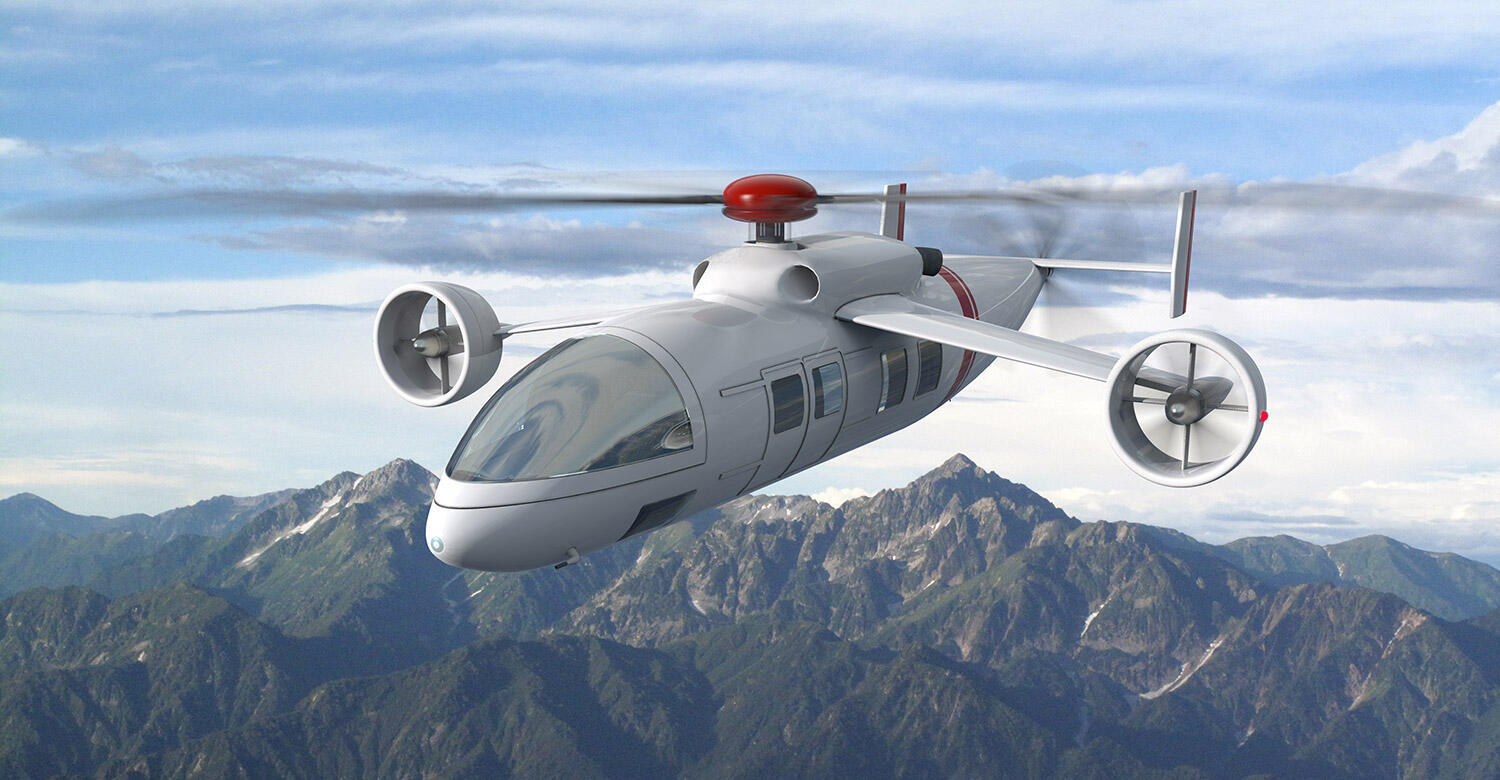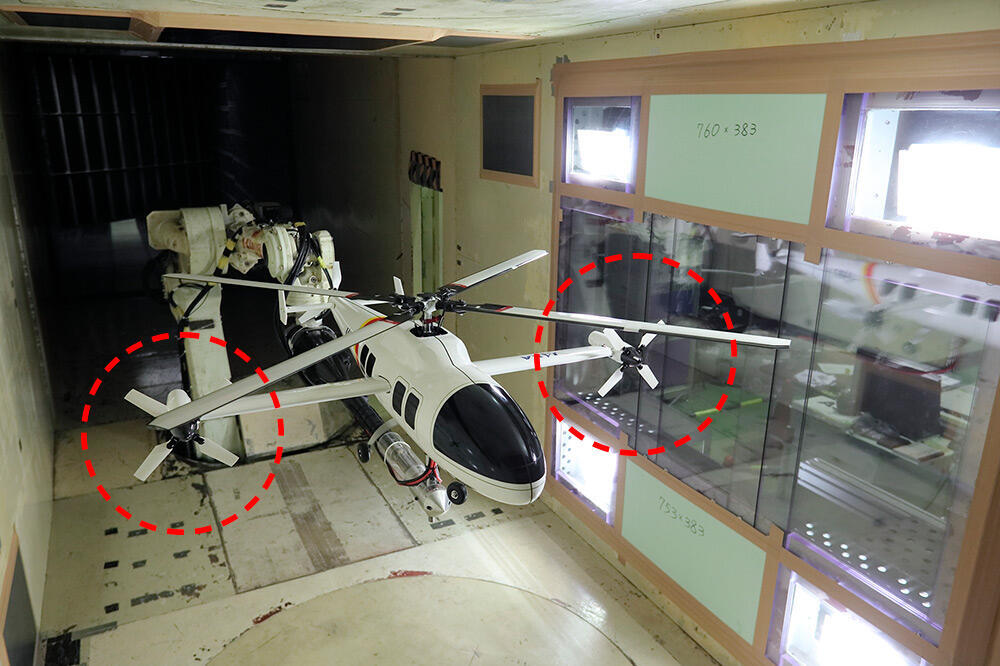
Aviation Technology Directorate

High-Speed Helicopters That Fly Twice as Fast as Conventional Rotorcraft
The aviation industry is expected to further evolve by the emergence of new
products, such as
supersonic passenger aircraft, electric aircraft and faster helicopters. Presently, the Aviation
Technology Directorate is conducting R&D to develop a helicopter that will fly twice as fast as
conventional rotorcraft and that with more flight stability.
TANABE Yasutada and SUGIURA Masahiko, Aviation Environmental Sustainability Innovation Hub, talk
about next-generation helicopters.
Aiming for a helicopter that flies at a speed of 500 km per hour
Helicopters account for a large proportion of aircraft used in Japan, specifically about 30% of
the total.
"Japan has few plains and is prone to disasters, and there is large demand for helicopters in
the country for the following two reasons. First, unlike fixed-wing airplane, helicopters can
take off and land vertically, which means that they do not need runways and can take off and
land even in narrow spaces. Second, they can hover in the sky," says SUGIURA Masahiko.
SUGIURA is an associate senior researcher at the Aviation Environmental Sustainability Innovation Hub. He is working on the development of a faster helicopter. Although helicopters are indispensable for the lives of Japanese people, according to TANABE Yasutada, manager for the Hub, technologies for helicopters have not been much advanced in Japan for recent 30 years while in the world new technologies for helicopters have been steadily developed. "We at JAXA are therefore striving to develop unique technologies for helicopters," says TANABE. The Aviation Technology Directorate is pushing ahead with measures to increase the safety of helicopters and improve the related technologies, including that to increase the speed. For a faster helicopter for which JAXA is promoting R&D, SUGIURA says as follows: "Conventional helicopters move forward by changing the rotor tip-path plane angle to use both lift and thrust forces and is, as it were, in the state of "treading water." In contrast, the faster helicopter that we aim to develop will be in the state of "swimming freestyle." It will use horizontal thrust to fly in a substantially different manner. The maximum speed of a conventional helicopter is about 270 km per hour, and we aim to nearly double it to 500 km per hour. Specifically, we changed the position and shape of the main wing and installed electric propellers to each edge of the wing. The electric propellers will counteract the torque (force that causes rotation) generated by the revolution of the main rotor mounted on the upper part of the helicopter, thereby enhancing the flight stability. Moreover, this anti-torque system can generate around 10% of the total required thrust force."

Increasing the speed of air ambulance helicopters
According to SUGIURA, faster helicopters could be used in a wide range of situations.
"An example would be air ambulance helicopters. If we can double the speed of air ambulance helicopters, more than 90% of areas in Japan are supposed to be covered in less than 15 minutes. Statics shows that provision of medical treatment within 15 minutes from the occurrence of traffic accidents can save many of the lives of victims who are severely injured, and faster helicopters are therefore needed particularly for the service."

TANABE also points out the financial merit gained by increasing the speed of helicopters used as air ambulances.
"In order to increase the coverage rate with existing helicopters, you will have no choice but to increase the number of medical facilities that serve as the emergency medical service bases. This will impose the cost of constructing the facilities and the personnel cost on you. Use of faster helicopters will be more cost-effective than increasing the number of the service bases even though you need to pay for somewhat more expensive helicopters as initial cost."
Background for the development and future outlook
For the background of the development of a faster helicopter, TANABE explains as follows:
"Before starting the project to increase the speed, we had been conducting research to reduce the noise of helicopters. After reaching a milestone for the research, we discussed with experts and those from manufacturers and research institutes including universities to determine what we should do next to improve helicopters. At the meeting, it was pointed out that research to increase the speed of helicopters was indispensable in particular for the emergency medical service and would be a very important mission for us to fulfill. We therefore started to conduct research on the theme."

"We had to make parameter analysis in a vast amount by using a computational fluid dynamics (CFD) analysis tool, and it sometimes took us one month to make a case analysis. Also, for example for the shape of the blade, it took us nearly two years to transform the proposed ideas into a concrete shape. I sometimes felt desperate, but we finally found the right answer and I still remember the excitement of that time. Going forward, we will be able to conduct tests by using the model helicopter, and I feel very happy about it."
They began making examinations for the concept of the high-speed helicopter in 2014. Then, in 2020, they started to develop the design technology for the practical use of the helicopter and conduct joint research with an aircraft manufacturer. In the future, JAXA will transfer the developed technology to the manufacturer for the development of a helicopter for practical use.
SUGIURA says, "It gives me pleasure to conduct joint research with a company in the private sector toward the practical use of a faster helicopter."
"As researchers, we tend to work on impractical things, but by working with companies in the private sector, we can become more aware of the social needs, and it gives us great pleasure to think that we have developed something that can be used practically in society."
Finally, TANABE concludes as follows:
"Helicopter manufacturers know much about manufacturing technologies that we do not know as they are actually making helicopters. In fact, by combining the technologies developed by JAXA through its various research activities with those of manufacturers who have practical knowledge in manufacturing, we were able to make a range of wonderful findings. Now we are working together for patent acquisition. I expect that faster helicopters will fly across Japan as air ambulances in the future."
Profile

|
|
|---|

|
|
|---|
All the images are copyrighted ©JAXA unless otherwise noticed.
- Home>
- Global Activity>
- Public Relations>
- JAXA’s>
- JAXA's No.87>
- High-Speed Helicopters That Fly Twice as Fast as Conventional Rotorcraft